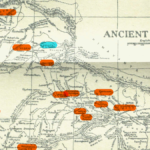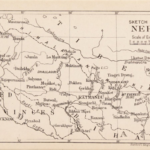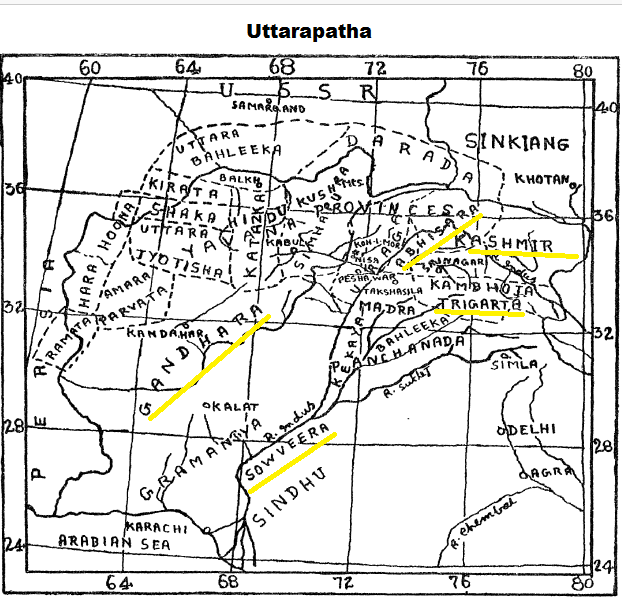
Introduction
Despite it serving as a political fulcrum of subcontinental politics today, Jammu has been historically overshadowed by its famous northern and southern neighbours, being alternatingly dominated politically by Kashmir and Punjab’s power players. Culturally, however, it is closer to Himachal, and historically its neighbours across the Indus.
“Dvigarta or the hilly areas of Duggara, presently, the Jammu region in the Indian state of Jammu and Kashmir.” [1, 21]
“This term [Trigarta] means the land watered by the three rivers, very probably the rivers Ravi, Beas and Sutlej. The country had formed an Aayuddha-jeevee Samgha or a confederation of six states—known as Trigarta-shashttha, according to Paanini. And they were living mainly on arms. They are mentioned as allies of the Kurus in the Mahabhaarata, but ultimately paying homage to Yudhishthira. According to the Abhidhaanacintaamani, the Trigarta country is identified with Jalandhara (Jalandharas-Trigarttah-syuh) but it is brought in close proximity with Kasmeera in the Raajatarangini…It may be located between the Ravi and the Sutlej with its capital near Jalandhar.” [7, 75]
Was Jammu historically part of Himachal’s Trigarta desa? The name Dvigarta (Dhvigartha) is an historical neologism being apparently coined some time around 1850 CE. The rationale is that just as Trigarta derives its name from the 3 riverine tracts (or lakes) that define its borders, so too does Dvigarta and its 2: Prachi Jammu and Pratheechi Jammu. Separated by the Ravi river, they are characterised by 2 almost mile-long sarovars (lakes). The former is closer to Himachal and historically came under the influence of the famous fort of Kangra. In many ways, Hill States form 1 common political culture, and in turn, frequently found themselves in confederations dating back to the Mahabharata and the Trigartas who fought Arjuna.
Yet, Western Jammu has its own character and had such contact with the Yavana (Indian Yavana, meaning ex-Aarya) kingdoms across the Indus that it was often the capital of those countries.
Legendarium
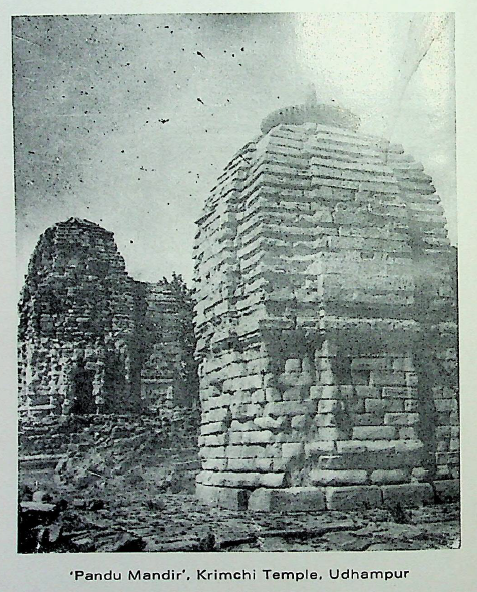
Historical origins are sometimes archaeological but usually mythical. Jammu is no such exception. How did this small region acquire such a distinct importance in the medieval and post-colonial era? Its position as a crossroads between Kashmir, Punjab, Gandhaara, and Himachal, made it the pivot on which Uttarapatha politics often turned.
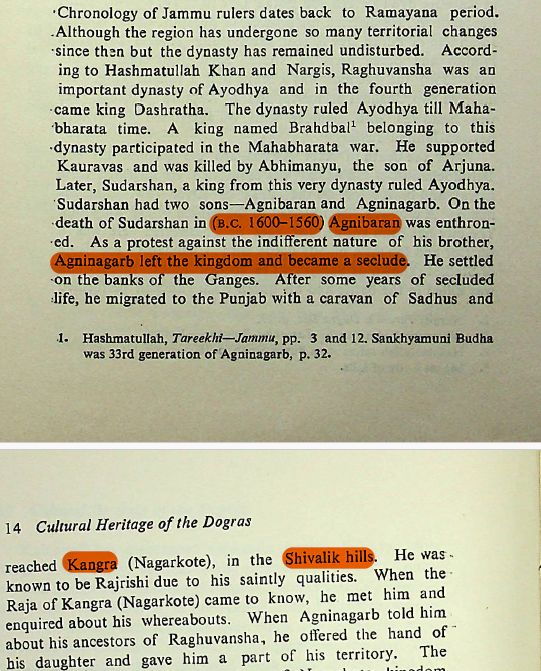
Jambulochana, a contemporary of the Gonanda Dynasty of Kashmir, is dated to the more fantastical 14th Century BCE. As discussed by Pandith Chelam, at least an entire millennium has been hacked off the historical Indic (Vedic) Chronology. Chandra Gupta I has been purposefully conflated with Chandragupta Maurya. Similarly, actual foreign rulers like the Kushaanas, have been post-dated and aggrandised. Kalhana confirms the rule of Kanishka, Huvishka, et al in Kashmir and Peshawar (Purushapura), but not much else. They were subsequently overturned in a Gonanda Dynasty restoration (all in BCE). Whether or not this is the case with Jambulochana as well, is a matter for historians to reconcile.
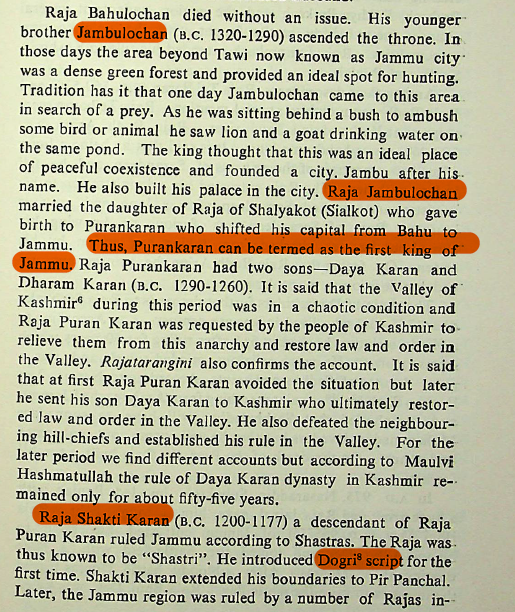
Jambulochana was succeeded by his son Purankaran, who is termed “The First King of Jammu”. His son Daya Karan, was requested to restore order in Kashmir. He did so, and his family is said to have ruled the Vale for about half a century. However, Jammu, and the later fortress-town of Bahu were not always the capital of the people of this region.[5, 109] A descendant of Purankaran, Raaja Shakti Karan is credited with the first introduction of Dogri script. [3, 15] And the rest, as they say, is history—or in this case, historical origin.
Origins
Pandit Chelam makes mention of the city of Raajapuri (Rajouri), which was under Bhaaratheeya Yavana kings. Sometimes under Kashmir’s suzerainty and sometimes serving as the capital of the Kambhoja Mahajanapaadha, if there has been a consistent political unit in Jammu’s antique past, it is Rajouri. It finds mention in his work as well as numerous others.
Kambhoja
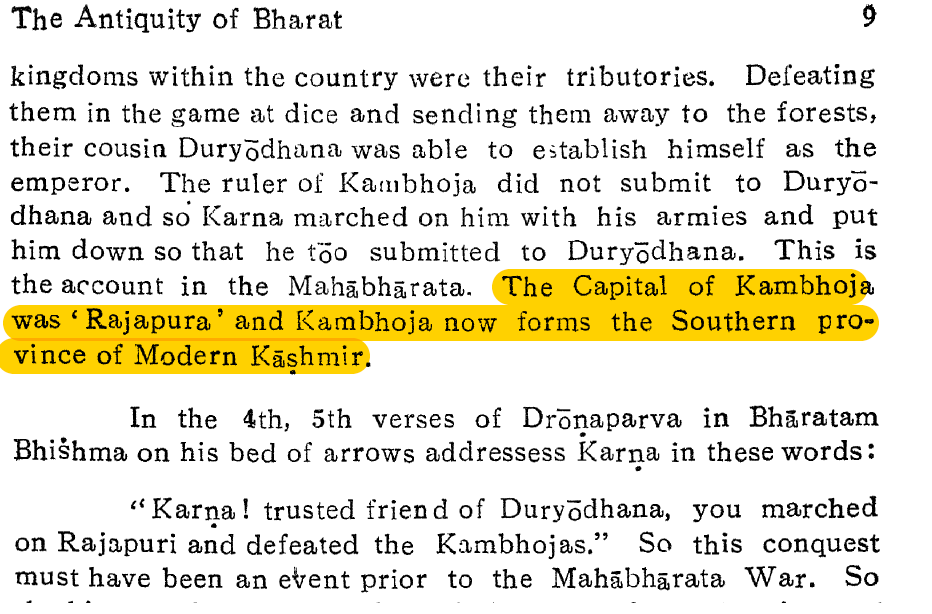
The Kambhojas are one such legendary people, famed for their beauty and valour but condemned for their laxity in morality.
“Devoid of any ethical values, the Dvijas become lovers of wine, meat, and other prohibited foods, become like stones without any feelings and stray from the path of Vaidic religion.” [1, 65]
Gandhaara
![[5, 9]](https://indicportal.org/wp-content/uploads/2024/08/JammuState-Gandhaara.jpg)
Gandhara Mahajanapaadha has attained a certain cachet in history, both Eastern and Western. It sat at the crossroads of Asia, much like Jammu sits at the crossroads of Northern India. By Vedic Indian reckoning, it straddled both Aaryasthaana and Yavanasthaana (ancient Afghan) at different points in time. Borders are rarely static over the course of millennia. On this count, Jammu is said to have been a province in Gandhaara during its apex.
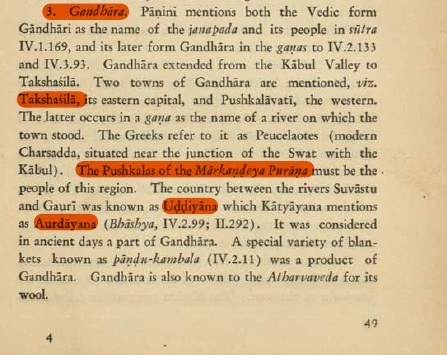
Abhisaara is the polity sometimes called Udayana (Uddiyaana) that includes Suvaasthu (Swat Valley) and Urasa (Hazara), which is definitely across the Indus. Alexander’s historians make mention of one Abhisares as intending to switch to his side (whether this was inclusive of Jammu & Kashmir at that time, is another matter).
Proper Indian sources, however, do not make mention of Alexander, whatever his interaction with and conquest of Frontier Indians (the actual Yavanas of Bhaaratheeya extraction).
Kashmir
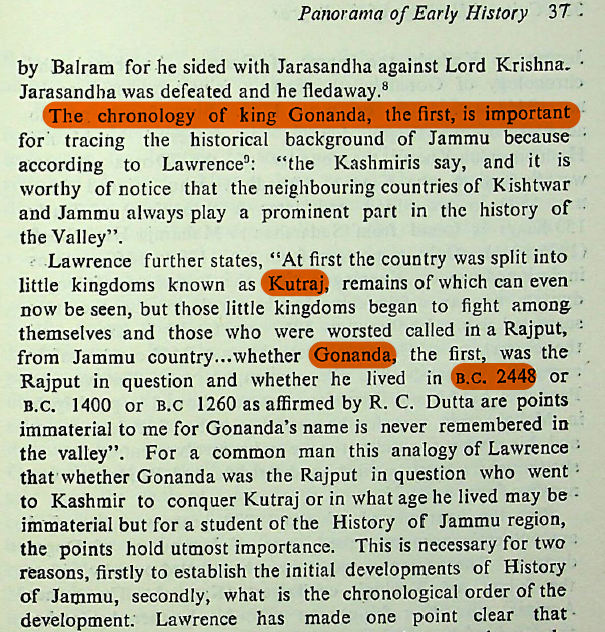
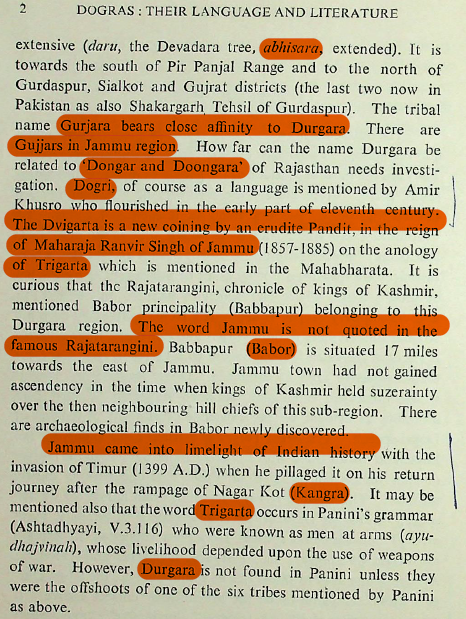
Important places today, such as Poonch will find their mention in the Rajatarangini, albeit in more antiquated form (Parnothsa). Valapura (Balor/Basohli), Babbapura (Babbor), and Kashtavatha (Kishtwar) are all recognisable as well.
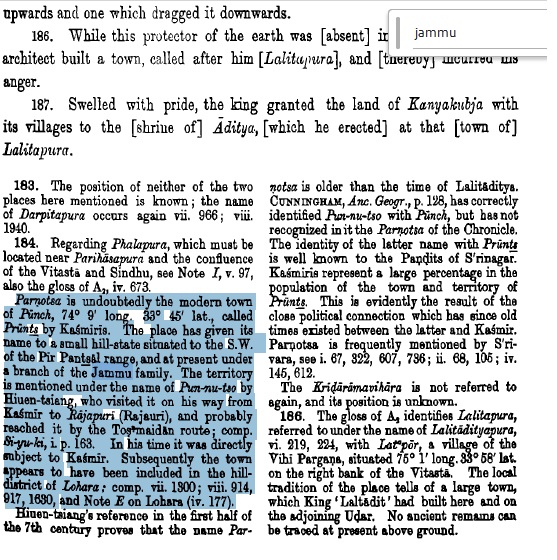
The Dogras
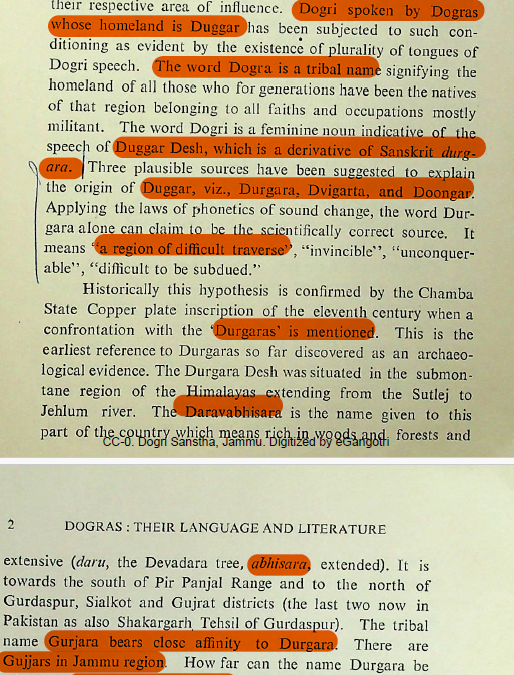
Jammu’s history of course is manifold greater than the mere founding of the town of Jammu by its namesake Jambulochana. The town of Bahu is the site of an ancient fort. The subsequent period of mughal rule, rebellion, independence, followed by Sikh & British rule in quick succession, make for another article. This is all the more so underscored by the political implications of these external actors on the native rule of Jammu denizens.

Culture & Religion
Along with Ethnicity, Culture & Religion serve as key characteristics for any people. Jammu is no exception. The population is primarily Hindu and today besieged by a myriad of threats both internal and external. Although the Dogra rule of Gulab Singh’s dynasty (a matter for another time) gave it stability and dignity within the Himalayan fold, it has subsequently chafed under the modern politics of Srinagar. Its identity has been disregarded, and its religion has been frequently targeted.
The Dogra people have a distinct language (Dogri), oft-revived script (Dogri & Takri), and notable literature. However, they are best known as a brave and tough people, with warrior inclinations. It is this quality that has kept them whole despite the vicissitudes of fate and history.
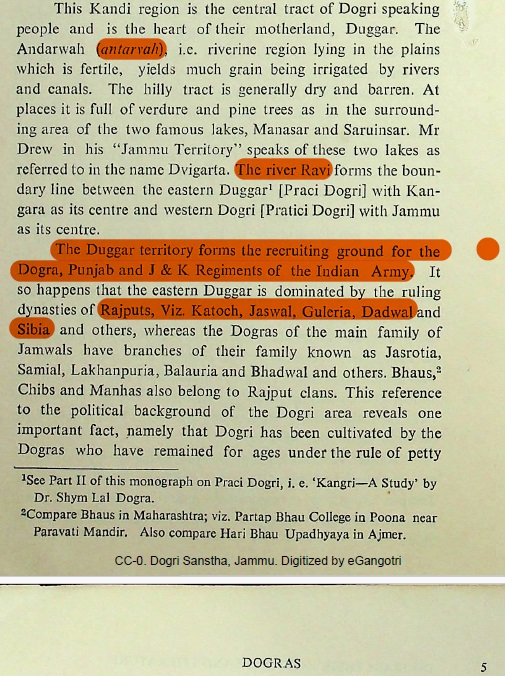
Conclusion

Like their brethren to the North, the people of Jammu have endured many a massacre and tyrant (including the wretched timur himself). And yet, throughout it all, they have survived and kept their heads held up high as Hindus.
Jammu is undoubtedly of tremendous importance. This is not only due to the access it grants to the Vale of Kashmir, but also due to the crucial role of hydrography here for the entire Subcontinent. But the interests and identity of the locals also matters. The Dogras (Rajput & otherwise) colour the region with their predominant character, which has a right of its own to prosper, flourish, and self-govern. A 50 years kingdom or 70 years state doesn’t define the people-group or dictate its identity.
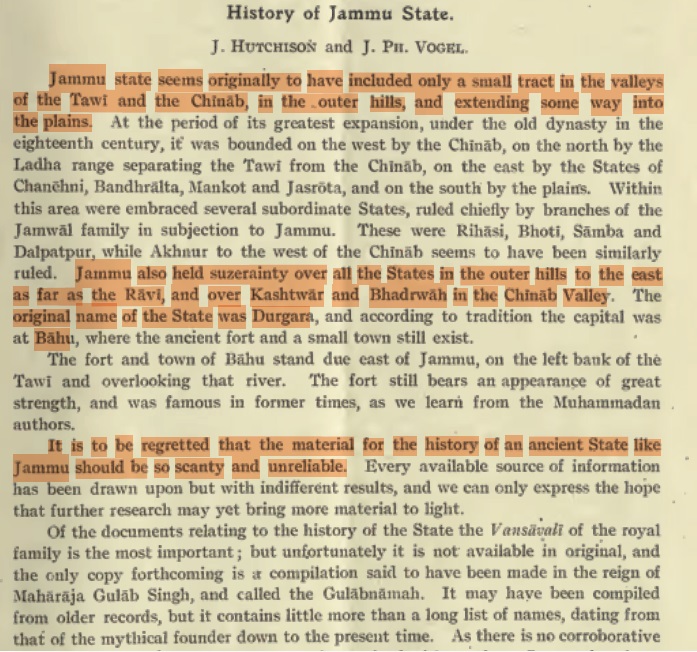
Indeed, long before Gulab Singh, it was Banda Bahadur (Lachman Dev), a Dogra Minhas Rajput, who was the region’s most famous son. He would go on to play a pivotal role in freeing Punjab, and unsurprisingly setting up his polity at Lohgarh, in neighbouring Himachal. The Hill States history and culture is a spectrum of continuity. The gradations may dilute at the edges, but they retain the strong flavour of bravery, Dharmic culture, and commitment.
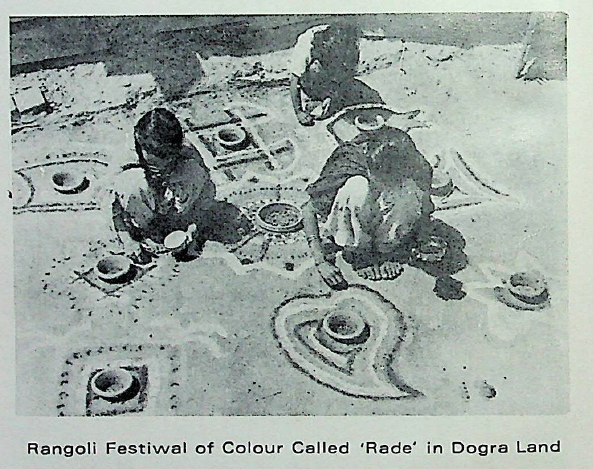
References:
- Shastri, Dev Rattan. Polity in Visnudharmottarapuranam. Tirupati. S.V.Vedic University. 2015
- Kota, Venkatachalam Paakayaji (Pandit). The Chronology of Kashmir. Guntur: Sri Ajanta. 1955
- Pathik, Jyoteeshwar. Cultural Heritage of the Dogras. New Delhi: Light & Life Publ. 1980
- Shankar, Prof. Gauri. Dogras: Their Language and Literature. New Delhi: Shri Bharat Bharati.1981
- Hutchison, J & J.Ph.Vogel. History of the Panjab Hill States. Vol I. New Delhi: Asian Educational. 1994
- Deambi, B.K. Kaul. History and Culture of Ancient Gandhara and Western Himalayas from Sarada Epigraphic Sources. New Delhi: Ariana Publ.1985
- Puri, B.N. India in the Time of Patanjali. Delhi: Munshiram Manoharlal Publ.1990
- Agarwala, V.S. India as known to Panini. University of Lucknow. 1953
- Stein, M.A. Kalhana’s Rajatarangini. Vol I. Westminster: Archibald & Co. 1900
